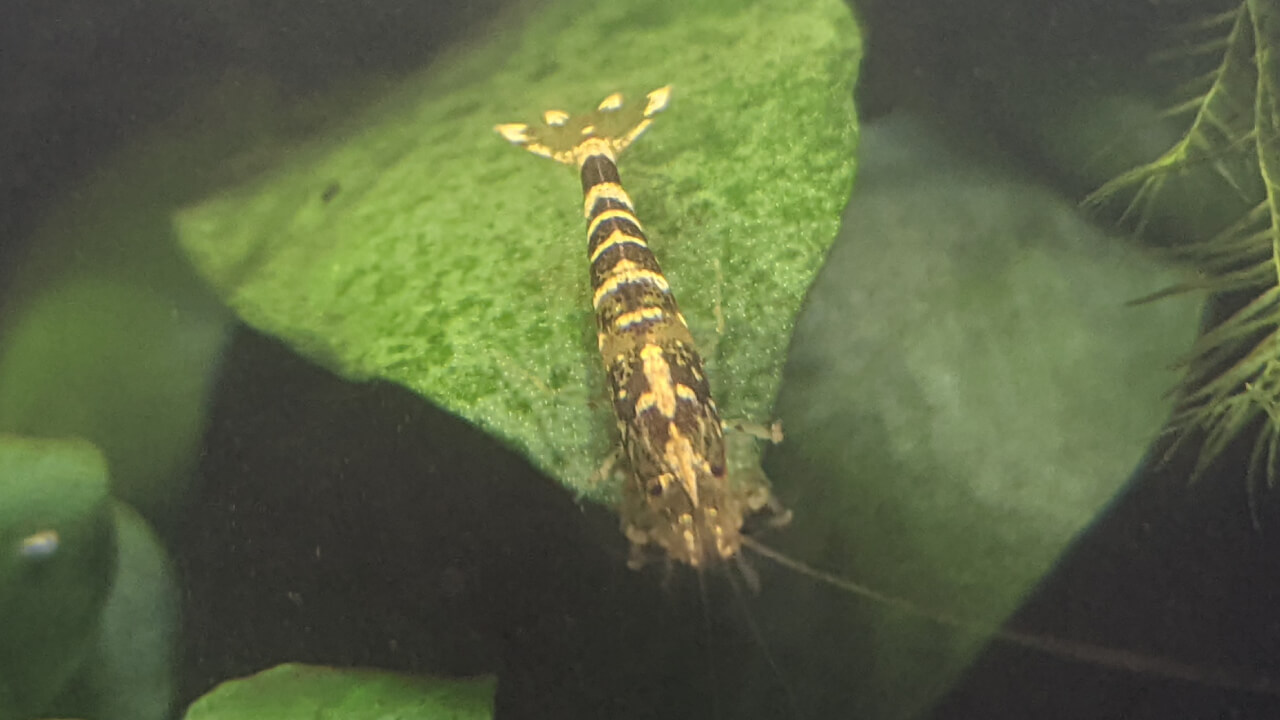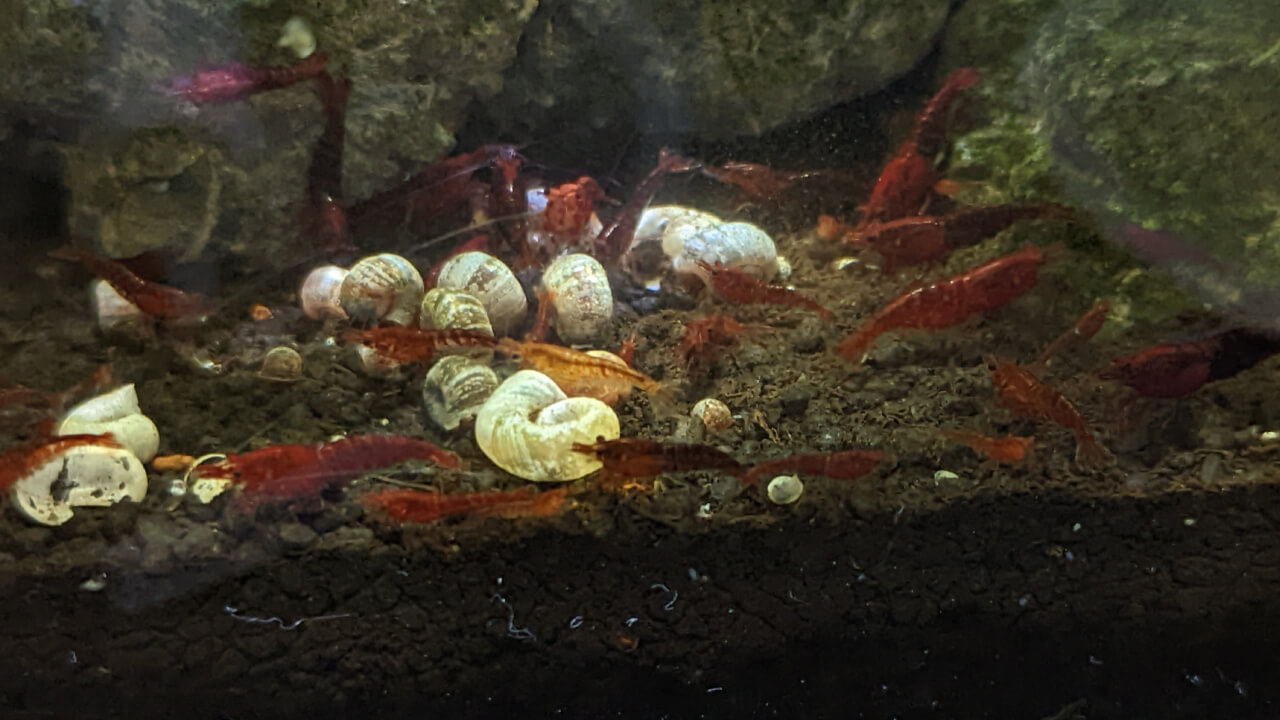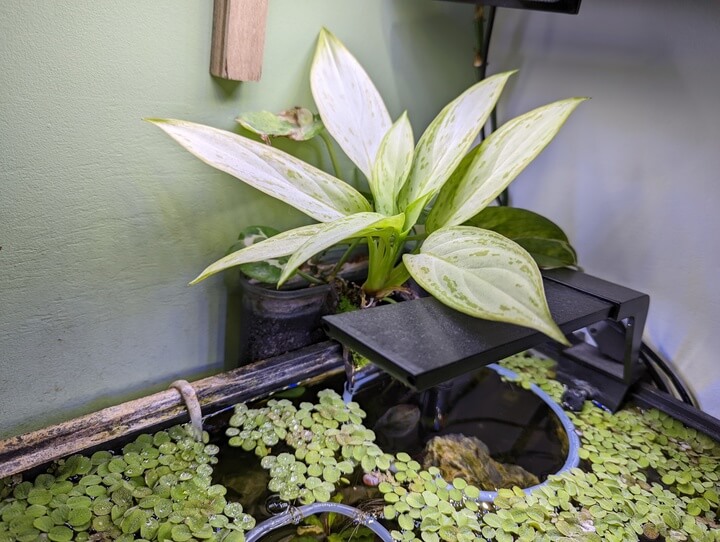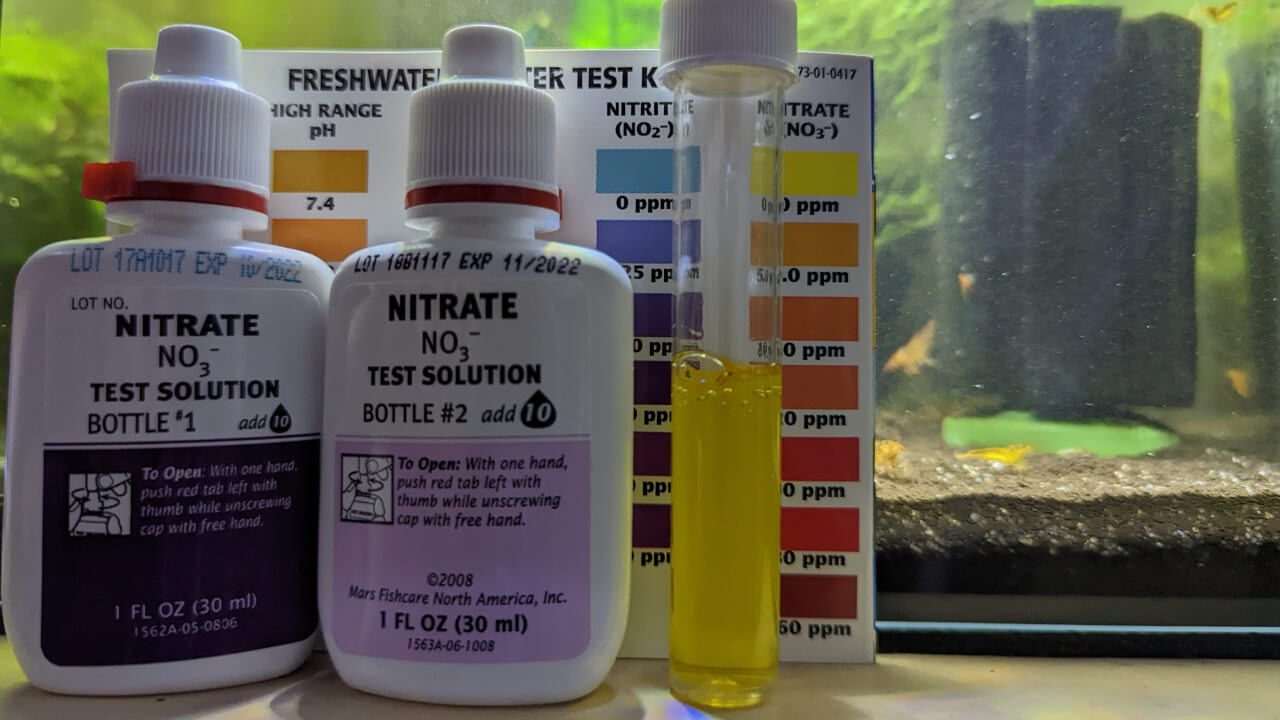Nitrates are chemicals created by your beneficial bacteria, by breaking down ammonia.
Nitrates are also a common ingredient in fertilizers for planted tanks.
While it’s less dangerous than ammonia, nitrates are still toxic to shrimp.
Don’t confuse nitrites and nitrates. They have a similar name, but nitrites are much more dangerous.
Where does it come from?
The nitrogen cycle in your tank is where most of the natural nitrate level will come from.
The beneficial bacteria living in your filter will convert ammonia into nitrates in a few steps:
- Ammonia is converted to nitrites
- Nitrites are converted to nitrates
In a fully cycled tank, any source of ammonia will get processed into more nitrates in the water.
Nitrates vs nitrites
Nitrite is the midway point of ammonia being converted into nitrate.
Nitrite is less harmful than ammonia, but it’s still very toxic and dangerous for shrimp. You want 0 ppm of nitrites in your tank.
If you have a nitrite level above zero, it’s likely your tank isn’t cycled fully.
Nitrates are what appear after your tank’s bacteria have processed nitrites. Nitrates are much less toxic than nitrites.
What level of nitrates is safe for shrimp?
Try to keep nitrates between 0 and 20ppm.
Compared to ammonia, you don’t need to have a reading of zero nitrates. Having a small amount of nitrates can actually be useful.
Nitrates can encourage algae growth, giving your shrimp more food to eat.

Your plants will grow well when there are lots of nitrates too. More plants and bigger leaves will add more surface area to grow biofilm, and give your shrimp more hiding spots.
It’s a good idea to keep nitrates as low as you can, though. As long as your plants are healthy, the lower the nitrates the better.
Once your nitrate level gets to around 40 ppm, you’ll start to see signs of stress in your shrimp.
Keeping well below this level will keep your shrimp colony thriving, and give you lots of time to react to any nitrate spikes.
Signs your nitrate level might be too high
There are a few common signs that your water parameters are stressing your shrimp.
- Swimming around a lot
- Staying near the water surface
- Not moving much
- Not eating
- Not breeding
High nitrates aren’t the only cause of these symptoms. You might see these same problems if you had an ammonia spike too, for example.
You should test your water parameters if you spot any of these signs, or changes in their behaviour.
Causes of high nitrate levels
Almost all the nitrate in the water will have originally come from ammonia.
This is why both ammonia and nitrates have the same causes. Reducing sources of ammonia will cut down your nitrates later.
- Leftover food rotting
- Shrimp and snail waste
- Dirty sponge filters
- Decaying plant leaves
Uneaten food breaking down

Food left in the tank will break down and pollute the water.
Overfeeding your tank is a fairly common way to get high ammonia and nitrate levels. You should only feed enough for your shrimp to eat within a few hours.
This is even more important with soft foods like vegetables, they break down and pollute the water faster.
Feeding with a small dish makes it easier to take out any leftover food later.
Lots of shrimp and snail waste
Shrimp and snails are very efficient creatures, managing to get nutrients out of almost anything.
As they’ve got such a small bioload, this makes their waste have barely any effect on the water.
However, given enough time, the poop can build up quite a lot. This can then lead to small spikes in nitrates and ammonia.
Vacuum your substrate to get rid of the waste build-up every few months or so.
A dirty sponge filter
A clogged sponge filter can hold on to a lot of waste.
This breaks down and gives your beneficial bacteria a lot of food to work with. The ammonia from the dirt then gets converted into nitrates.
Obviously, having beneficial bacteria is good. If they can process a lot of ammonia in a short period of time, that’s also helpful.
But, lots of ammonia will obviously result in lots of nitrates at the end of it. As you’re trying to keep nitrates below 20 ppm, this can be risky.
Clean your sponge filters every few months or when they’re obviously dirty and clogged up.
Decaying plant matter
In planted tanks, old leaves die off and break down to give nutrition for the newer plant growth.
This is basically a weaker form of fertilizer.
You don’t need to remove dead plants from your tank unless you’ve a got lot of them. Shrimp and snails will normally eat them before they can cause problems.
Lots of dying plants could even be a sign that your nitrates, or other nutrients used by plants, are too low.
How to reduce nitrates
- Do some water changes
- Add some plants, especially floating or emersed plants
- Use a water conditioner
- Remove detritus with a gravel vac
1. Do water changes
Removing waste from the water is one of the main reasons we do water changes in our tanks.
As soon as your nitrate level gets close to the 20 ppm threshold, you should plan to do a 10-20% water change.
It’s important to be consistent with this, so that you don’t stress your shrimp by swinging the water parameters too much.
2. Add more plants
Plants will absorb both ammonia and nitrates from the water.
Each plant won’t take in a lot, but over time and multiplied with lots of plants, it can make quite a big difference.
This is the idea behind how a Walstad tank works. They rely on having a lot of plants taking in the ammonia, instead of using a filter for beneficial bacteria.
The normal bottleneck for underwater plant growth is lack of carbon dioxide. They can only get access to whatever amounts dissolved into the water.
Floating plants don’t have this problem. As they can get the carbon dioxide directly from the air, they can absorb even more nitrates and grow faster.
If you’ve got a Hang on Back filter, or relatively high hardscape, you could try growing some emersed plants.

Emersed plants
Cuttings of fast-growing plants, like Pothos, are pretty popular in planted tanks.
If you don’t have high hardscape, or an external filter, you can use suction cups to hold cuttings instead.
You can get ones with a small loop, big enough to hold the stem of a plant. You’ll be able to choose the perfect height and position on your own too.
3. Dose a water conditioner
Water conditioners/detoxifiers contain a binder that makes all ammonia, nitrites, and nitrates non-toxic.
Seachem Prime is a very popular detoxifier and water conditioner.
This happens almost instantly, making your water safe again for shrimp in just a few minutes.
The nitrates will still be in the water, just in a less dangerous form. You should treat this method as a temporary solution.
You’ll need to find and fix the source of ammonia and nitrates. It’s sensible to do a water change after dosing too.
4. Vacuum the substrate
Keeping your substrate clean by vacuuming it every few weeks can reduce nitrate build-up.
Removing the waste and leftover nutrients prevents them breaking down and dissolving into the water.
Conclusion
Nitrates aren’t as dangerous as nitrites or ammonia, and can even be useful in a planted tank.
Try to keep your nitrate level at or below 20 ppm to prevent stressing your shrimp.
Adding lots of plants, especially floating or emersed, is a great way to keep your nitrates under control.

